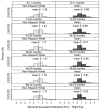Prevalence of myopia, hyperopia, and astigmatism in non-Hispanic white and Asian children: multi-ethnic pediatric eye disease study
- PMID: 23953098
- PMCID: PMC3902090
- DOI: 10.1016/j.ophtha.2013.06.039
Prevalence of myopia, hyperopia, and astigmatism in non-Hispanic white and Asian children: multi-ethnic pediatric eye disease study
Abstract
Purpose: To determine the age-, gender-, and ethnicity-specific prevalence of myopia, hyperopia, and astigmatism in non-Hispanic white (NHW) and Asian preschool children.
Design: Population-based, cross-sectional study.
Participants: A population-based sample of 1501 NHW children and 1507 Asian children aged 6-72 months from Los Angeles County and Riverside County, California.
Methods: Eligible children underwent an in-home and in-clinic interview and a comprehensive eye examination including cycloplegic autorefraction from 100 census tracts.
Main outcome measures: The proportion of children with myopia (spherical equivalent [SE] ≤-1.00 diopter [D]), hyperopia (SE ≥ +2.00 D) and cylindrical refractive error ≥1.50 D in the worse eye. The astigmatism type was defined as with-the-rule (WTR; +cylinder axis 90°±15°) and against-the-rule (ATR; + cylinder axis 180°±15°); all other orientations were considered oblique (OBL).
Results: The prevalence of myopia, hyperopia, and astigmatism in NHW children was 1.20% (95% confidence interval [CI], 0.76%-1.89%), 25.65% (95% CI, 23.5%-27.9%), and 6.33% (95% CI, 5.21%-7.68%), respectively. The prevalence of WTR, ATR, and OBL astigmatism in NHW children was 4.33%, 1.00%, and 1.00%, respectively. Prevalence was lower with older age groups for astigmatism (P = 0.0002), but not for myopia (P = 0.82) or hyperopia (P = 0.31). In Asian children, the prevalence of myopia, hyperopia, and astigmatism was 3.98% (95% CI, 3.11%-5.09%), 13.47% (95% CI, 11.8%-15.3%), and 8.29% (95% CI, 7.01%-9.80%), respectively. The prevalence of WTR, ATR, and OBL astigmatism was 6.50%, 0.80%, and 1.00% respectively. The prevalence of hyperopia was higher in girls than boys (P = 0.0002), but no differences were found for myopia and astigmatism.
Conclusions: Hyperopia was the most common refractive error in both Asian and NHW children. However, compared with NHW children, myopia was relatively more prevalent, and hyperopia less prevalent, among Asian children. The prevalence of astigmatism was greatest in infants, and WTR astigmatism predominated at all ages. Myopia showed relatively stable prevalence across age groups, whereas hyperopia prevalence decreased after infancy and then increased again in older age groups; however, longitudinal studies are needed to evaluate refractive changes over time in individual children.
Financial disclosure(s): The authors have no proprietary or commercial interest in any of the materials discussed in this article.
Copyright © 2013 American Academy of Ophthalmology. Published by Elsevier Inc. All rights reserved.
Figures





Comment in
-
Ethnic difference in myopia between Asians and non-Hispanic whites in the United States.Ophthalmology. 2014 Mar;121(3):e17. doi: 10.1016/j.ophtha.2013.11.010. Epub 2013 Dec 15. Ophthalmology. 2014. PMID: 24342018 No abstract available.
References
-
- Varma R, Deneen J, Cotter S, et al. The Multi-Ethnic Pediatric Eye Disease Study Group. The Multi-Ethnic Pediatric Eye Disease Study: design and methods. Ophthalmic Epidemiol. 2006;13:253–62. - PubMed
-
- Thibos LN, Wheeler W, Horner D. Power vectors: an application of Fourier analysis to the description and statistical analysis of refractive error. Optom Vis Sci. 1997;74:367–75. - PubMed
Publication types
MeSH terms
Grants and funding
LinkOut - more resources
Full Text Sources
Other Literature Sources
Miscellaneous

